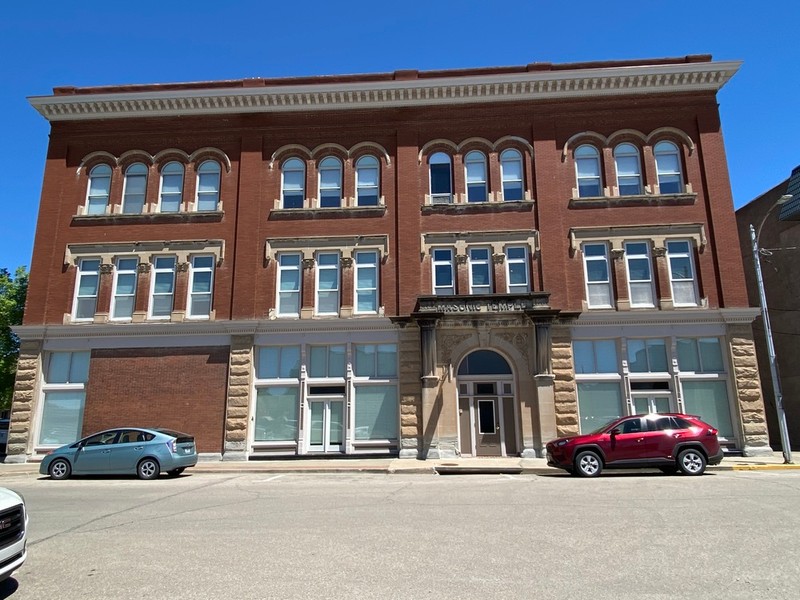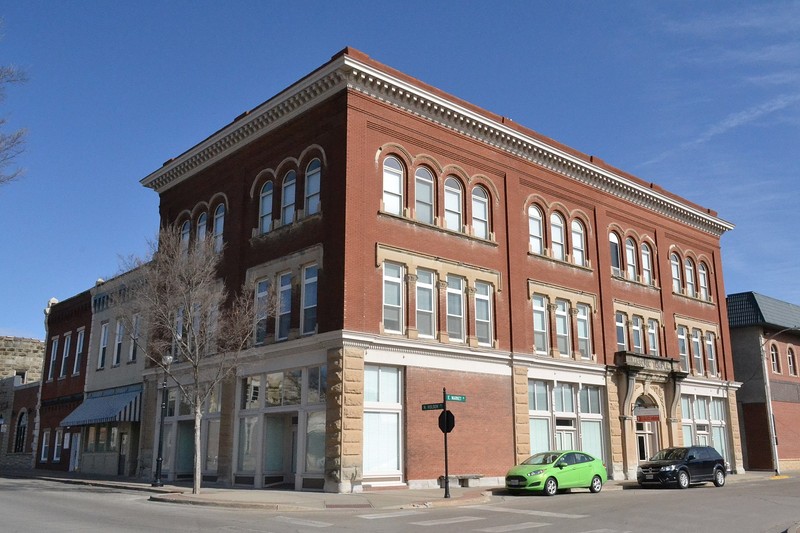Masonic Temple
Introduction
Text-to-speech Audio
Warrensburg's Masonic Temple was built between 1893 and 1894, and the building served as the meeting hall of Corinthian Lodge # 265 until 1980. Freemason membership grew substantially during the late nineteenth and early twentieth centuries, and Masonic organizations like this one played significant roles in communities offering social organizations that also supported philanthropic efforts, education, and community service. The Warrensburg Masonic Temple demonstrates the nationwide influence of Free Masons in the 19th and early 20th centuries. During these years, membership was limited to men and this fraternal model of membership gradually declined in the 20th century leading to the decision to sell this large building in favor of a more modest headquarters. Declining membership in fraternal organizations has led to the sale of numerous Masonic temples and other buildings previously owned by fraternal orders in cities across the United States. Construction of this building in 1894 was part of a shift where Holden Steet gradually displaced Main Street as Warrensburg's business, social and economic center, mainly due to Holden's proximity to the railroad.
Images
Masonic Temple in Warrensburg Missouri

Masonic Temple in Warrensburg Missouri

Backstory and Context
Text-to-speech Audio
Freemason membership in the U.S., mainly comprised of white males, grew substantially during the late nineteenth and early twentieth centuries. Masonic organizations played meaningful roles in communities, including establishing schools and colleges, building social and meeting halls, and influencing everything from business development to politics. Construction of the Masonic Temple in 1894 occurred a few years before the historic courthouse opened in 1898, marking the period where Holden Steet displaced Main Street as Warrensburg's center of activity, mainly due to Holden's proximity to the railroad. The large, highly ornate building stood as one of the most impressive Masonic buildings in the region, demonstrating its significance.
As the nineteenth century progressed, social groups emerged within growing cities and regions. It is believed that Freemasonry (Masonry) has roots in the guilds of cathedral builders during the Middle Ages, arguably making it the world's oldest organized group. Masonry reached the Missouri Territory in 1807, four years after the Louisiana Purchase and fourteen years before Missouri became a state. The establishment of the Masonic Grand Lodge of Missouri, which had the authority over local lodges throughout the state, took place in 1821. By the mid-nineteenth century, the Grand Lodge made education a priority. In 1844, the organization opened Masonic College in Marion County, Missouri, one of the first (if not the first) colleges of its type to open in the U.S. Though it closed shortly thereafter (in 1847), the group established another college in 1848, located in Lafayette County. Graduates included a Governor, two U.S. Senators, and a U.S. Representative. Despite its success, the college proved too costly, notably during the period of unrest leading up to the Civil War, so it closed in 1859.
Johnson County's first Masonic lodge -- Johnson Lodge No. 85 -- was organized in Warrensburg on April 13, 1846, about ten years after the town had been platted and predating most of the town's early churches. Its first meeting hall existed on Main Street in the heart of Warrensburg during its early days. The first floor doubled as a public school and religious meeting house, demonstrating the significance of the organization. However, Lodge No. 85 disbanded at the start of the Civil War, and the community eventually demolished the building.
Shortly after the Civil War, two new Masonic lodges were created in Warrensburg. The first was Warrensburg Lodge No. 135, organized in 1867, while the second, which ostensibly formed because Lodge No. 135 denied admittance to several would-be Masons, was Corinthian Lodge No. 265 in 1868. Several years later, Lodge No. 135 disbanded. Consequently, its members joined Corinthian Lodge No. 265. One of its first officers, George R. Hunt, went on to become Grand Master of the Grand Lodge of Missouri. The membership grew to 104 members (roughly 2.2 percent of Warrensburg's population) by 1890, one of the largest lodges in west-central Missouri. Despite the existence of a national financial crisis in 1893, the members of the Corinthian Lodge made plans to raise money and establish a permanent meeting hall. Construction took place between June 1893 and June 1894, when it opened.
Warrensburg's Masonic Temple is exceptional because of its impressive architecture. The building's size, Victorian Italianate styling, and extensive decorative sandstone made it possibly the largest and most ornate Masonic building constructed in Missouri. (The building also included modern features such as electricity.) The sandstone, which came from local quarries north of Warrensburg, can be found in numerous public and commercial buildings in west-central Missouri built during the period. The Masonic Temple stood as the second-largest building on Warrensburg's public square next to the Johnson County Courthouse, which opened in 1898. The two imposing buildings represented Warrensburg's economic and political center transition, from the old Main Sreet area to the Holden Avenue corridor, primarily due to the arrival of the Missouri Pacific Railroad in the mid-1850s.
The third floor served as a meeting hall for Corinthian Lodge No. 265 and other Masonic bodies for eighty-seven years. The Masonic Temple Association also rented parts of the first floor to businesses and rented office spaces on the second floor. In 1900, female relatives established Warrensburg Chapter No. 3 of the Order of Eastern Star; they utilized rooms on the third floor.
By 1900, Lodge No. 265 had 126 members, representing 2.7 percent of Warrensburg's population and, nationwide, Mason membership reached nearly 855,000 people. Both in numbers and population percentage, the growth of the lodge continued through the 1920s. A belief existed by many that the "best" men in the community were Masons, often bolstered by the press. For example, an editor from The Journal-Democrat attended a banquet after the new lodge opened. He wrote: "Masonry is known by its principles and by its works; its accomplishments for the good of humanity are not secrets, and its work in a social way was seen and enjoyed last night by scores of people who can testify to its success. Long live the Masons!" Furthermore, fourteen U.S. Presidents have been Masons, including George Washington and Harry Truman of Missouri.
Things changed for the Masons during and after the Great Depression. Masonry's popularity declined steadily during the middle and late twentieth century, despite the group's attempts to assimilate to modern society. Thus, memberships fell significantly. In 1980, some 87 years after the construction of the Masonic Temple, Corinthian Lodge No. 265 (through the Masonic Temple Association) sold the historic lodge and moved into a new, one-story building.
Sources
"1893-94 Masonic Temple Built / Shepard's Dry Goods Opens." Show Me the History: Johnson County & West-Central Missouri (blog). 1973whsreunion.blogspot.com. May 13, 2017. https://1973whsreunion.blogspot.com/2017/05/1893-94-masonic-temple-built-shepards.html.
Maserang, Roger. "Nomination Form: Masonic Temple." National Register of Historic Places. mostateparks.com. 1998. https://mostateparks.com/sites/mostateparks/files/Masonic%20Temple%20Johnson%20County.pdf.
Taylor, Jon. "Masonic Temple Warrensburg Missouri." University of Central Missouri History Program Historic Missouri. historicmissouri.org. Accessed November 4, 2021. https://historicmissouri.org/items/show/5.
University of Central Missouri History Program photo ~ Creator: University of Central Missouri History Program ~ Date: May 2021. Located digitally at https://historicmissouri.org/items/show/5
By 25or6to4 - Own work, CC BY-SA 4.0, https://commons.wikimedia.org/w/index.php?curid=66194820
